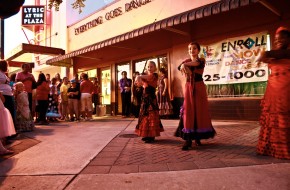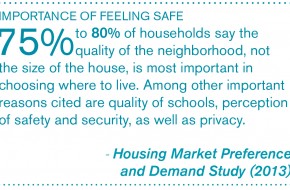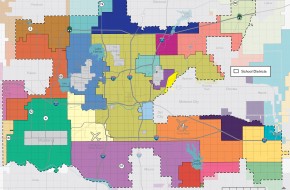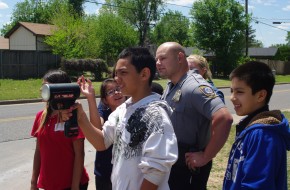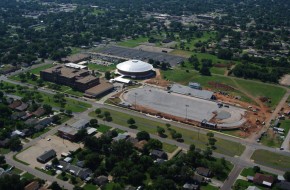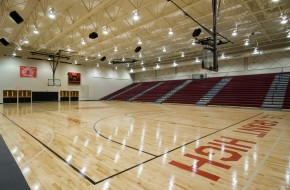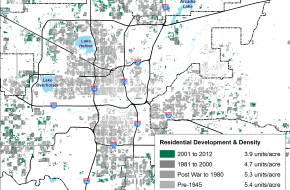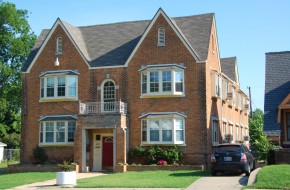Our Situation
Neighborhood Stability and Safety
Over the years, Oklahoma City’s urbanized area has grown much faster than its population, reducing density and frequently causing population loss in older neighborhoods. This pattern also contributed to increased long-term vacancy and abandonment in residential and commercial buildings and produced socioeconomic divisions as people with different incomes lived, shopped, and worked farther apart from each other. These conditions erode the physical fabric and social glue of neighborhoods, which often result in increased and concentrated poverty, decline of community space and institutions, and serious safety concerns.
Vacant and abandoned structures. Changes in the location and nature of employment, shifting demographics, and almost half a century of declining demand for new construction in urban settings have left many abandoned properties throughout Oklahoma City. Many of these properties have excellent access to City services. However, according to the 2013 Vacant and Abandoned Building study, their abandoned status significantly reduces their ability to contribute revenue used to pay for those services. Additionally, abandoned buildings tend to attract criminal activity and transient populations (“squatters”), both of which require higher levels of police and fire services than occupied buildings.
Poverty and crime. When neighborhoods begin to decline, demographic and income segregation quickly follow. People with the means to move do so, leaving concentrations of low-income households. National trends show a high relationship between concentrations of poverty and increased crime rates, poor school performance, and decline of social institutions. This cycle is very difficult to break, and presents a significant challenge for many parts of the city.
Social fabric. We know that community identification and spirit are important outcomes of a living neighborhood, and in many cases are more important than physical appearance. However, social fabric is also a victim of neighborhood decline and isolation. People become disengaged, and participation in churches, schools, and community organizations drops. Facilities where a robust civic life should take place, like shops, parks, playgrounds, libraries, and community centers are either absent or viewed as unsafe. Routine connections within the neighborhood or to other parts of the city, like sidewalks, local streets, and transit service decline and along with them, the civic networks by which people reinforce one another. When the organizing elements of community life unravel, disorganization sets in and what were once centers of life and comfort become places to fear. The most challenging part of a neighborhood development strategy is reversing this trend, and rebuilding places where community life again flourishes, hope is restored, and opportunity is again created.
City action and a comprehensive plan like planokc cannot solve all the complex problems of neighborhoods. We can, however, help create a neighborhood environment that provides safe places for learning; remove nuisances and deterioration which foster feelings of insecurity; provide space for community contact; and begin to rebuild the physical infrastructure.
Healthy food options. The greenokc element examines agricultural and food issues and the distribution of fresh food outlets in the city. The issue of food access has attracted national attention, and bears repeating in this element. People are interested in eating healthier, but access to healthy options can be challenging in Oklahoma City, where only 10 percent of households live within a half-mile of a grocery store. This situation leaves many households with very few options to access reasonable food choices. There is another dimension to the food issue. Local grocery stores often function as meeting places as well as food outlets, and their presence or absence may be viewed as a measure of confidence in the viability of a neighborhood. Growing food locally in establishments like community gardens or urban farms does not yet supply a significant source of healthy food in Oklahoma City.
Environment and public safety. Elements of the public realm transmit messages about the health of a neighborhood. Poor street and sidewalk conditions, overgrown landscape, poor lighting, and hidden areas reinforce a sense of decline and create hazards to public safety. Streets and places that are devoid of routine activity like pedestrian traffic and lack visible doors and windows decrease the number of “eyes on the street” and lack a sense of individual territory and ownership both of which are important components of places that feel safe.
Program persistence. Much of our crime prevention programming has shown success, but too often, resources are not sufficient or forthcoming for sustaining them over the long term. As a result, gains can be lost without comprehensive community revitalization as a program component.
Schools
Schools are the traditional focus of a neighborhood, and community and school success are highly inter-related. Neighborhood decline can reduce educational performance, which in turn reduces the marketability and leads to further deterioration of the neighborhood, which in turn further impacts the schools, and so on in an ever degrading cycle.
Demand versus location. As families with children move away from many urban neighborhoods, the location of facilities no longer matches the location of students. This strains school districts’ ability to maintain and improve facilities. Additionally, new school sites, especially in suburban locations, are often selected without considering long-term neighborhood or community goals for growth and neighborhood design.
Ownership. Over the years there has been a growing disengagement between schools and their neighborhoods. The breaking of physical and social connections reduces interest in the quality of the services provided by the school, erodes concern and support for re-investment in facilities, and contributes to the inefficient use of public resources. This problem has been reinforced by the closure of schools with low attendance. When a neighborhood loses its school, it loses an important part of its identity and ability to sustain itself, and the resulting shift in student population can generate new transportation problems.
Multiple school districts. Oklahoma City contains portions of 27 school districts, reducing the ability to address regional educational issues on a cooperative basis, and creating inefficiencies through duplication.
Housing
All neighborhoods need a satisfactory supply of safe, affordable, quality housing to maintain their population and attract new residents. Issues related to housing supply at the neighborhood level include housing choice, condition and maintenance, construction quality, and economics.
Housing choice. More than 90% of the housing built during the last two decades consists of single-use subdivisions of detached single family homes or as large apartment complexes. This homogeneity leaves residents few viable housing options to choose from. The Housing Market Preference and Demand and Community Appearance studies both indicated a growing demand for more diverse types, including small-lot single-family, attached single-family (such as townhomes), and urban multi-family developments. Greater variety is especially appropriate in revitalizing communities and urban districts near major job centers such as Downtown, the Oklahoma Health Center, and the State Capital complex. In addition, some new housing should provide environments to accommodate the growing desire of older adults to age in place.
Condition and maintenance. Poor property maintenance and structural deterioration can quickly degrade neighborhood quality and property value. This raises the dual problem of 1) reducing the supply of quality housing and 2) discouraging reinvestment. Publicly funded housing rehabilitation programs are often not sufficient and/or not implemented in a manner to create the necessary “tipping point” where public and private dollars can effectively reverse neighborhood decline.
Construction quality. Maintaining existing housing is very important, but the quality of original construction is a significant factor. Some lower-cost single and multi-family housing built during the past 20 – 30 years appear to lack long-term durability. While these homes provided affordable housing for several years, their relatively rapid deterioration has created and will continue to create long-term challenges for residents, neighborhoods, businesses, and the City.
Housing economics. Low housing values discourage new development and rehabilitation in urban neighborhoods. Low rents do not provide the cash flow necessary to support upgrading existing units or build new housing. New homes are rarely built in areas where the cost of the new home is well above the market value of surrounding homes. This market condition restricts new development and redevelopment. These economic issues can stall and prevent needed new development, rehabilitation, and reinvestment in older neighborhoods and untested areas.
























 Download PDF
Download PDF